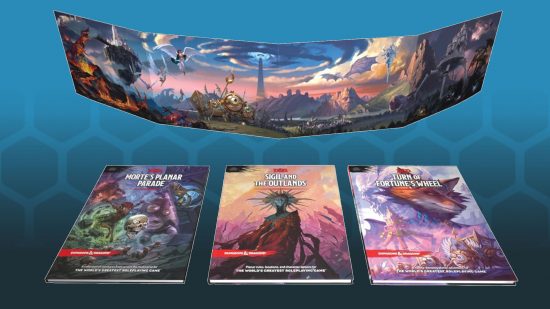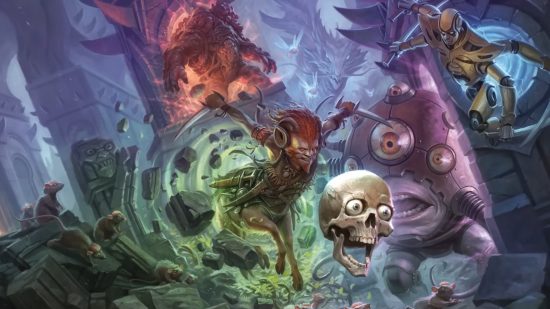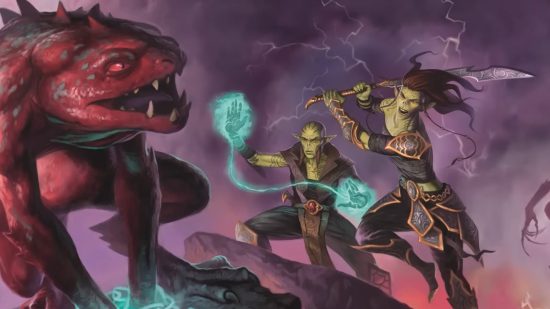Our Verdict
Dungeons and Dragons' Planescape 5e boxed set is filled with wonders, but the three books only scratch the surface of what the setting could be.
The new Planescape 5e books have big shoes to fill. As a remake of a beloved setting, it must balance the needs of new fans with the desires of the die-hard. And as a three-book set, it strives to offer a comprehensive setting guide, varied bestiary, and a rich campaign. Does it have merit? Absolutely. Does it meet all these expectations? Not exactly.
Wizards of the Coast kindly provided us with a Planescape: Adventures in the Multiverse review copy, and we’ve formed our beliefs based on a thorough readthrough of the material. Belief is a powerful thing in Planescape, so let’s break down this boxed set (and you can decide whether we’re brilliant thinkers or berks).
What is Planescape: Adventures in the Multiverse?
Planescape: Adventures in the Multiverse is a boxed set of three DnD books that introduces the classic Planescape setting to fifth edition players.
First, there’s ‘Sigil and the Outlands’, a DnD setting book that maps out its titular locations and the inhabitants you can expect to meet. These creatures are expanded on further in ‘Morte’s Planar Parade’, which includes 54 DnD monster stat blocks, many of which we first saw in second and third edition Dungeons and Dragons.
The boxed set also includes a pre-written DnD campaign, ‘Turn of Fortune’s Wheel’, which takes players from levels three to 18. One of its standout features is the ‘glitch’ mechanic. Thanks to some multiverse-related mishaps (which we won’t spoil), characters can return from the dead as an alternate-universe version of themselves.
Along with the sourcebooks, Wizards of the Coast has thrown in a Dungeon Master’s screen to boot. While the regular version of the set features all-new artwork, the alternate ‘local game store’ covers use new images from Tony DiTerlizzi, an artist who’s synonymous with the original Planescape material.

Who is Planescape: Adventures in the Multiverse for?
This art isn’t the only nod to the source material in Planescape: Adventures in the Multiverse. Many of the setting’s key locations, monsters, and characters have been lovingly recreated. However, Planescape 5e largely feels like an appeal to new players rather than old.
Part of this comes from the boxed set’s tone. Planescape 5e is more fond of jokes and japes than its grim, edgy parent, and the philosophy and cynicism that previously defined the setting is lost. This is a modern makeover for the setting that brings it in line with recent releases like Journeys Through the Radiant Citadel and last year’s nostalgia-fueled remake, Spelljammer: Adventures in Space.
Is Planescape 5e good or bad?
In terms of quality, Planescape 5e sits somewhere between Radiant Citadel and Spelljammer. One is a whistle-stop tour of vibrant settings, populated with interesting characters and thoughtful storytelling. The other is Spelljammer – a watered-down shadow of its original self.
Things are much better than they were in Spelljammer, but Planescape 5e still suffers from its boxed set format. For the second time, Wizards has tried to force an enormous, expansive setting into a collection that’s only a fraction longer than the average D&D book.
Its setting book reintroduces some fantastic content to fifth edition, but it feels lacking because it has to share space with a bestiary and a full adventure. Factions, one of the most iconic features of the original Planescape, are squashed into just seven pages, as Wizards needs all the breathing room it can get to outline the city of Sigil and the various towns of the Outlands.
Also, as a side note – this isn’t a set to pick up if you’re a player. There are a handful of 5e feats and DnD backgrounds in the setting book, but nothing new for DnD classes or DnD races. The player options introduced are intriguing, but they’re not going to appeal in any campaign outside of the Planescape setting.
‘Sigil and the Outlands’ provides an interesting and approachable introduction to an incredible setting, but it always chooses breadth over depth. Expect to do plenty of your own research and writing if you plan to set a game here.
Planescape’s new campaign suffers similar limitations. Yes, the adventure is able to reach higher-than-expected levels because it skips a few after the players reach level ten. But even so – 96 pages is a sparse, fast-paced adventure. Compare this to Curse of Strahd, another level three to ten adventure that spans over 200 pages.
Both books regularly introduce novel ideas, but they often fail to follow through. The setting book has plenty of creative adventure prompts that’ll feel really special when somebody plans them out in more detail.
‘Turn of Fortune’s Wheel’ regularly introduces varied and exciting encounters – and drops the ball by not fully fleshing them out. Several parts of the campaign could lead to unusual, grave, or complex situations depending on how a party rolls, but Planescape 5e expects you to figure out how to run those yourself.
And then there’s the glitch characters. The campaign opens with a delightfully chaotic dungeon, as players wake up in a morgue with no memory of how they got there. It encourages off-the-wall decision-making and introduces the idea that characters need to recover their lost memories and figure out who they are. But this thread isn’t really carried through the campaign.
Introducing a new generation of D&D players to Planescape is a worthy pursuit, and Wizards has managed to bottle some of the original setting’s magic with its new books. For a committed DM, there’s a mound of inspiring and exciting content to use as a springboard.
But the setting book and adventure are skeletons – shiny ones, but still just the bare bones of what could have been if three books weren’t crammed in the same box.




